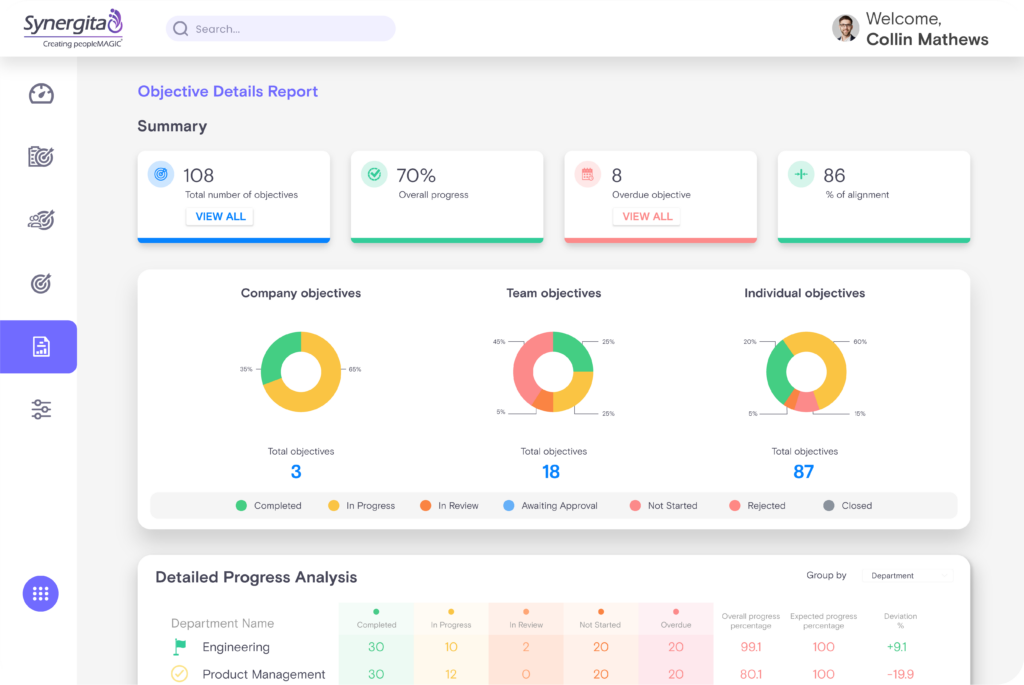12 Reasons Why OKRs Work
Smart businesses work towards a common goal, and the only way they meet their goals is to be clear-eyed and focused. And the way they know they have completed their goals is by recognizing the tangible results. OKRs, or Objectives and Key Results, make it relatively straightforward as they not only help define the organizational objectives and goals to meet them but also show the desired results at the end of each milestone. Adopting OKRs sets the employees on the path and steers them in the desired direction. If there is doubt about OKRs‘ effectiveness, the twelve reasons listed in this blog should suffice to implement OKRs in your organization. But first, let’s define OKRs.
What are OKRs?
OKR is an acronym for Objectives and Key Results. It is a proven practice adopted by the world’s leading organizations, and its popularity is gaining ground as businesses of all sizes across different industries find OKRs the most effective in setting and meeting business objectives. Furthermore, OKRs also take employees on the journey toward professional success. Organizations have benefitted from this approach in several ways and have seen more success in a shorter period.
Furthermore, OKRs also take employees on the journey toward professional success. Organizations have benefitted from this approach in several ways and have seen more success in a shorter period.
Benefits of OKRs
Some of the benefits of implementing OKRs in the organization include the following:
- Increased focus and alignment: OKRs help focus the organization’s efforts on the most critical goals and ensure everyone knows what they are working on.
- Improved performance management: OKRs provide visibility into how individuals contribute to the organization’s success, helping to ensure that everyone is on the same page and working towards the same goals.
- Better accountability: By tracking progress, or the key results against objectives, OKRs provide a clear way to measure and reward performance.
- Increased transparency: OKRs provide visibility into the organization’s objectives and progress, creating a shared understanding of what must be achieved and how it will be measured.
- Improved collaboration: OKRs help teams coordinate their efforts with complete cooperation and open communication to identify areas for improvement.
- Better decision-making: OKRs help organizations prioritize their efforts and resources by focusing on their most important objectives and staying on track with frequent reviews.
These are but a few of the benefits of OKRs. There are several reasons why OKRs are most effective in driving business success, twelve of which are listed in this blog.

12 reasons why OKRs are effective
OKRs work consistently and are adaptable to organizations of different team sizes. The advantage of bringing OKRs into an organization is that they are scalable and can be adjusted according to employee strength. Some of the reasons why OKRs work includes the following:
Staying aligned:
OKRs enable organizational alignment, connecting every department, team, and the individual employee. The objectives set by the employer cascade down to individuals and groups, helping them develop goals aligned with the organization. OKRs help establish why individual contribution matters and how it fits into the larger picture.
Flexibility and adaptability:
OKRs allow continuous improvement and don’t require a one-size-fits-all approach. This flexibility makes adjusting objectives and key results easier as the environment changes.
Promote collaboration:
OKRs encourage teams to work together to achieve their objectives. This encourages collaboration and communication and helps create a culture of shared responsibility.
Measurable metrics:
OKRs provide tangible and measurable targets that can be tracked and evaluated. They allow individuals and teams to set SMART goals, measure their progress, and identify areas for improvement.
Provide clarity:
OKRs provide a clear and structured goal-setting system that makes it easy to break down according to each milestone and track progress. They help ensure everyone is on track and working towards the same goals.
Ensure accountability:
By setting objectives and key results, OKRs ensure everyone is held accountable for their performance, helping individuals and teams deliver high performance and taking ownership of their roles and responsibilities while working to their full potential.
Offer transparency:
OKRs are typically visible to everyone in the organization, which helps ensure all employees across different business units are on the same page and aligned with the organization’s goals.
Encourage innovation:
Aspirational and motivational OKRs challenge teams to think outside the box and come up with creative solutions to achieve their objectives. It encourages innovation and helps teams to stay ahead of the competition.
A sense of urgency:
OKRs set a timeline for achieving objectives and require teams to take action to reach their goals. They help prioritize what matters most, creating a sense of urgency to ensure team members stay focused and aligned as they work towards the same target.
Trackable and action-oriented:
OKRs focus on concrete and achievable goals, which helps ensure teams remain action-oriented and don’t lose their direction by pursuing off-tangent abstraction. The ability to track further ensures that all employees can view and measure their progress, helping them adjust their focus if necessary.
Promote employee engagement:
OKRs help employees feel motivated and focused, as they can track their progress, set goals, and measure their success. They empower employees to take ownership of their objectives and feel accomplished when they reach them. Employees are better engaged when they work in a culture of growth and support, as OKRs help create an environment of collaboration and communication.
Dynamic and quicker turnaround time:
Since OKRs are typically set every quarter and enable flexibility, employees can adapt and make changes immediately if necessary. OKRs are never set once and forgotten after. They are frequently reviewed based on new ideas or in anticipation of changes.
While the above 12 reasons make OKRs imperative in today’s digital landscape, they are by no means the only ones. OKRs are scalable and can be revised quickly, without any long-term impact on budget or resources, making them a cost-effective approach.

Here are a few real-life examples of how OKRs work.
An example of Organizational OKRs
O: Business expansion to Asian markets
KR1: Identify Asian market demands and 2-3 gaps that we can fill
KR2: Evaluate our offering to ensure they meet new market requirements
KR3: Expand the sales team by at least three to serve the Asian market
An example of Team OKRs
O: Increase customer satisfaction scores
KR1: Create and send 50 online surveys to existing customers
KR2: Increase the number of favorable reviews by 60%
KR3: Ensure a Net Promoter Score of 9.0
Examples of individual OKRs:
O: Increase customer satisfaction
KR1: Increase customer satisfaction score by 2%
KR2: Respond to customer inquiries within 24 hours
KR3: Implement customer feedback into product development
O: Improve team collaboration
KR1: Hold weekly team meetings to foster communication
KR2: Use collaborative tools to share ideas and information
KR3: Increase team members’ participation in decision-making processes
In conclusion
OKRs are a powerful goal-setting system that helps organizations reach their objectives with a single-minded focus. By setting measurable goals and creating a culture of individual ownership and shared responsibility, OKRs help teams stay motivated, on track, and always aligned with the organization.
